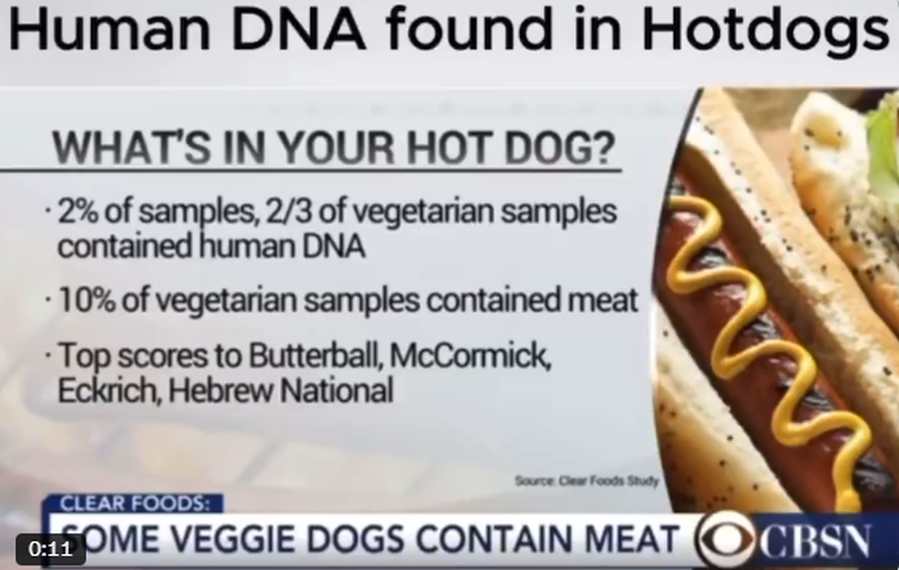Does your hot dog really have human DNA? The claims of the virus many years ago have made rounds again, plunging social media into a frenzy. Some say it will appear in vegetarian hot dogs. But what is actually happening here? The story goes back to a 2015 report by food testing company Clear Labs.
Social media was lit up early when x-user @wallstreetapes rekindled old controversy.
“Two-thirds of the ‘vegetarian’ hot dogs tested included meat. 10% of all vegetarian products had meat.
Clear Foods analyzed 345 hot dog and sausage products from 75 brands. I got this – human DNA was found in 2% of the samples. Contains two-thirds of vegetarians. ”
“Yeah, it appears that 10% of all vegetarian products contain meat.”
The post quickly went viral and gained over 1.9 million views in just a few hours. But like many online claims, the complete story is more complicated.
Hot Dog Human DNA: What Science Really Says

Where it all began
It all began in 2015 when Clear Labs analyzed 345 hot dog and sausage products from 75 brands sold at US retailers. Using genome tests, they looked for labeling issues, contamination, and private ingredients. Of the entire sample, 2% reportedly contained traces of human DNA. They also found that 10% of vegetarian products contain meat, with two-thirds of which have some kind of inconsistency, like pork or poultry, which has not been declared.
When the survey results reached the media, the response was quick and dramatic. News and social posts interpreted “human DNA” as “human meat” and the rumored factory took over.
What science actually says
Human DNA in food does not mean someone threw their fingers into a meat grinder. Genome experts point out that small amounts of human DNA can come from innocent sources such as skin cells and stray hair from workers on the line. These trace amounts are often picked up during routine handling and can be easily flagged by sensitive testing methods such as PCR (Polymerase Chain Reaction).
Dr. Michael Doyle, a microbiologist at the University of Georgia, summed in 2015 as “not unexpected.” He explained that these trace levels are contingent and not of health concerns. The FDA agrees. MinorEnvironmental DNA does not violate food safety standards and is usually degraded by processing or digestion.
Even Clear Lab revealed that human DNA is likely due to not wearing gloves or not following proper hygiene, rather than some kind of horror story.
Vegetarian twist
The portion about the meat that appears in vegetarian hot dogs also attracted a lot of attention. In some cases, products labeled as meat-free contain animal protein. This is due to cross-contamination of facilities that handle both types of products.
Several social media posts go further, claiming that two-thirds of vegetarian hot dogs have mixed human DNA. That’s not what the research said. The main issue was not human DNA, but meat contamination. These exaggerated claims seem to be a mashup of various discoveries with dramatic spins.
What regulators say
USDA’s Food Safety Inspection Services (FSI), which handles meat and poultry products, has strict hygiene regulations. The FDA, which is responsible for non-food products, also requires companies to follow good manufacturing practices. Both agencies looked at clear lab findings to confirm that Trace’s human DNA was not considered dangerous or a violation of food safety regulations.
They also strengthened their commitment to investigating misconceptions and cross-contamination, especially with products sold as vegetarians or vegans.
Clear Lab also faced scrutiny.
Not everyone was impressed with the Clear Labs report. Critics pointed out that it has not been peer-reviewed and does not provide clear data on how much human DNA has been discovered. The sample size (345 products) is not small, but it barely damages the surface of the number of hot dogs on the market.
Food Safety News called the findings “preliminary” and questioned whether the report was more about advertising than science. Without peer reviews and transparent methodologies, it is difficult to put too much weight on claims.
Social media throws gasoline on fire
Posts from large accounts like @dailyloud and @wallstreetapes helped me get the bill back into circulation a few years after the report. But they often are boring – but skipped boring, but important details so that trace amounts of DNA can’t rival danger. Instead, the post surprised fear and doubt, adding emojis and eye-opening headlines to maximize reach.
This uncontextless alarm cycle is a textbook example of how misinformation spreads and sticks spread.
How to maintain your sanity (and safety)
If you’re wondering what you can actually do as a consumer, here’s a short list:
Buy from a trusted brand with excellent track record and quality control.
Read the label and look for USDA Organic, non-GMO project verification, or other certifications.
If you suspect that something is off, call USDA (1-888-mphotline) or FDA.
It relies on facts, not on virus posts. Stick to reliable sources.
Final Thoughts
Yes, human DNA was found in some hot dog samples. No, that doesn’t mean munching people at the Cookout on July 4th. What is the most likely cause? It expires in hygiene, like people who don’t wear gloves. The bigger problem with the report was that meat appears where it should not be, especially in vegetarian products.
Science says there is no threat to your health. The regulator agrees. However, as long as social media continues to run with half the truth, such stories continue to resurface.
So next time you shoot the grill, feel free to enjoy that hot dog. You have bigger things than you worry about.
Check out the original video below.
🚀Want to share the story?
Submit your stories to TechStartUps.com in front of thousands of founders, investors, PE companies, tech executives, decision makers and tech leaders.
Please attract attention
Source link

